Website forms the backbone of an organization in today’s digital world. In the overflow of information and competitors, it becomes a platform for an enterprise’s identity. Companies spend a lot of resources on web application development. The primary goal remains to ensure digital presence through an engaging web app, and this changing digital marketing trend has altered business operations.
Previously, the focus remained only on manufacturing, marketing, and profits. However, digital communication has also become a major point of concern. Modern web development is a primary tool to ensure digital presence. The process requires particular hardware and software tools that enable web developers to create useful website platforms. Enterprises get support from a web app development company that can provide the necessary personnel and tools to design web pages.
In this article, we will explore the definition and components of a web development stack. We will also focus on the selection process for the right tech stack for an organization and the best options available in the market today.
What is a web development stack?
Web development stack is a group of web development technologies that aid the process of developing web applications. It consists of several software tools, including programming languages, databases, and web development frameworks.
Defining Web Development Stack
Web development stack refers to the software tools needed for the web creation process. It consists of a set of technologies, including databases, programming languages, and frameworks that are integrated to build a web application. It is also known as a web technology stack. Software developers also use online libraries and patterns in addition to other tools to create appropriate web pages.
In the fast-paced transition of digital spaces, web development tools are also undergoing drastic change. Businesses have a diverse range of options for software development. As per Statista, the enterprise software market has experienced high levels of growth in recent years. IT spending to develop enterprise software is expected to reach 675 billion USD in 2023. Hence, web development technology plays a key role in supporting companies on digital platforms.
Web development companies must hire skilled personnel that has a strong understanding of the many aspects of the process and good command over its tools. It is also essential for the clients or users to comprehend the web development stacks used by software developers to ensure the required criteria for their web apps are fulfilled. As a development stack can be used repeatedly in creating web apps, companies must specialize in a specific stack or several stacks.
Components of a Web Development Stack
Every stack in the development process is aimed at fulfilling a different task. It is highly dependent on the development and operation of a web application. As a result, software developers need to use specialized processes to design web pages. It leads to a complicated process of handling web development stacks.
However, for the sake of simplicity, web developers divide a web stack into two main components: front-end and back-end development. It creates a division of the software development process into two parts, making the management of web app stacks easier.
Let’s take a deeper look into each component of web stack development.
What are the main components of a web development stack?
Some of the major components of a web development stack can be listed as follows:
- Front-end stack development: (HTML, CSS, JavaScript)
- Back-end stack development: (Database, Web Server, Web development framework, Programming language)
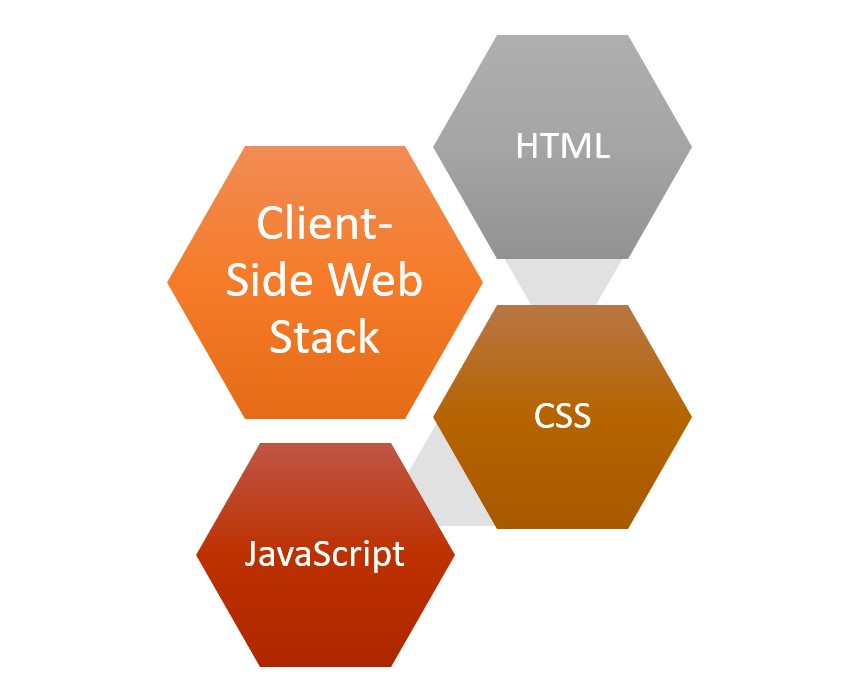
Front End Web Development Stack - Client Side
Front-end web development stack refers to anything that a user directly interacts with on a web page. Hence, it is also known as the client side. It controls the design, navigation, and overall structure of the web application. Since it is the main platform for user interaction, it is crucial for front-end developers to ensure a great UI/UX design for a smooth user experience. Following are the primary tools that complete the front end of a web technology stack.
HTML
It is a programming language that forms the foundation of a web application. It determines the construction of web pages by controlling the design and display of data on the page. It also manages the highlighted text for a search engine. HTML 5 is the latest version of the markup language in use nowadays. Since it supports video and audio data unlike the past variants, it offers greater versatility in designing web pages.
CSS
Also known as the cascading style sheets, it is a template language that monitors the outlook of information on a web page written in HTML. It primarily deals with the font, size, color, and other layout components of the information on the page. It also enables the addition of explanations and labels to an electronic document. Web developers often use extension languages, like SCSS, SASS, and LESS to overcome the limitation of CSS.
JavaScript
It is a programming language that is used to manage the interactive features of a web application. It allows the development of dynamic content on web pages, increasing the overall interactivity of the front end. It also supports the addition of web animations on the website, enhancing the user experience.
With the three core components of the front-end web development stack, software developers aim to create a holistic user experience for the audience. It is focused on creating an interactive outlook of a web page with excellent UI/UX design.
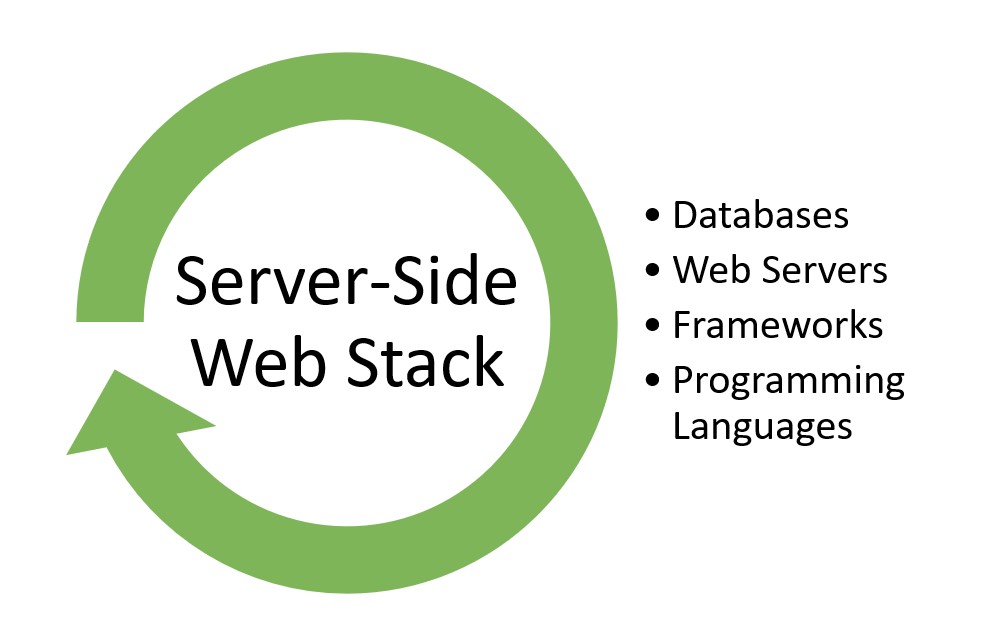
Back End Web Development Stack - Server Side
It is a part of the web development stack that determines how the web app works. This side is not visible to the users and is a complete part of the backend development. Hence, it is also called the server side. Its components work in the background to ensure the smooth processing of information for the user on the front side.
Some of the basic parts of back-end web development include:
Databases
They provide storage space for the entire web development process. All the data, user information, and other items are stored in the databases. Most applications use an SQL or NoSQL database. Other commonly available databases include MySQL, PostgreSQL, and MongoDB.
Web Servers
Web servers provide a pathway for the front end of the web technology stack to connect with the back end of the process. Any requests or demands made by the customer in the web app's front end are sent back to the web servers. They enable search engines, applications, and servers to communicate with each other to oversee customer demands.
Frameworks
These are programs that support web development processes that are based on a single programming language. Web development frameworks offer ready-to-use templates and other components, speeding up the backend development process. The best option should perform all the needed functions for the web development stack. Some of the common web frameworks available in the market include Laravel, Ruby on Rails, and Django.
Programming Languages
They constitute the logic of the website and applications, ensuring a connection between both. The primary goal is to provide an interface for the web to the database. While a single language is sufficient to develop a web app, many complex cases use multiple programming languages in the development phase. Examples of some commonly used web development languages include PHP, Python, and JavaScript.
It is the integration and alignment of both the front and back ends of the web development stack that results in the completion of a web project. They bring together several components of the development process, and it is crucial for a software developer to understand the function and role of each part.
List of Common Web Development Stacks
Web developers working on tech stacks require specific skills and knowledge to work with the package of servers, programming languages, HTML, and other components. Some software experts excel in languages like CSS, HTML, and JavaScript, making them great front-end developers. However, full-stack development requires complete knowledge of the back-end and front-end parts of the web development process.
The types of technology stacks are categorized in a similar way as web development experts. The frameworks available in the market are classified into three main types: front-end, back-end, and full-stack frameworks. Let’s take a look at a list of some of the common web development stacks.
What is the most popular web stack?
The most popular web stack for 2022 has been the MEAN Tech Stack. It is a large-community open-source stack that enables quick and efficient development of applications.
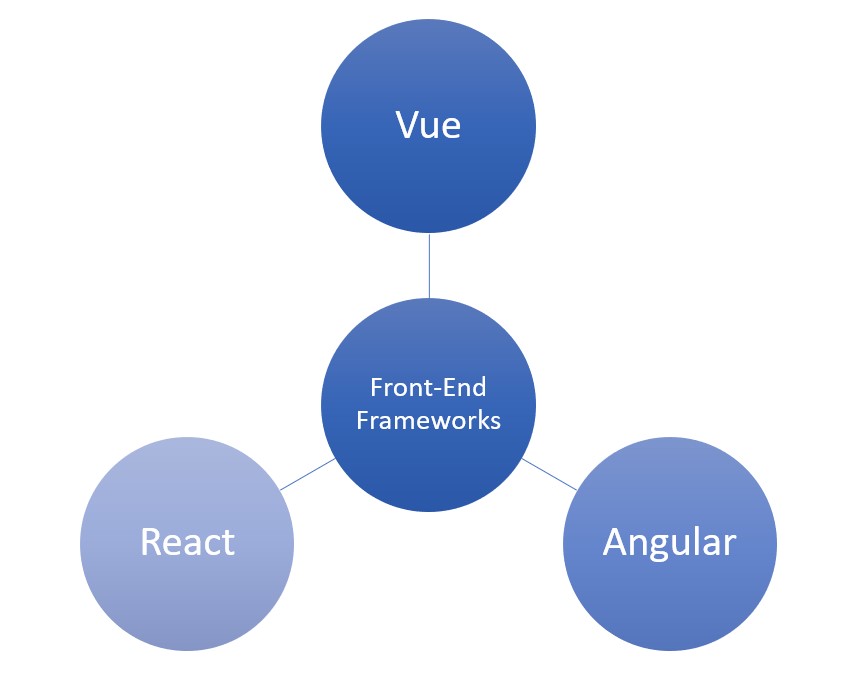
Front-end Frameworks
Front-end frameworks are commonly based on JavaScript as this programming language can easily be linked with the Open Web Platform. Some of the common types of these front-end frameworks include:
Vue
Created in 2015 by Evan You, it is a front-end framework that is used to create single-page applications. It is an open-source JavaScript framework that consists of a core library and several supporting libraries. It allows the binding of HTML controls to data and vice versa. Moreover, it can be developed in increments that ease out the scalability process as per the needs of an enterprise.
Angular
It is also an open-source framework maintained by Google to develop single-page web applications. It enables two-way data binding that ensures a responsive user interface. Moreover, it also connects easily with other libraries, making the interface versatile and easy to use.
React
React is an open-source framework. It is used for the creation of user interfaces and the development of UI components. This front-end framework is developed by Facebook and is a web development tool used heavily by the organization.
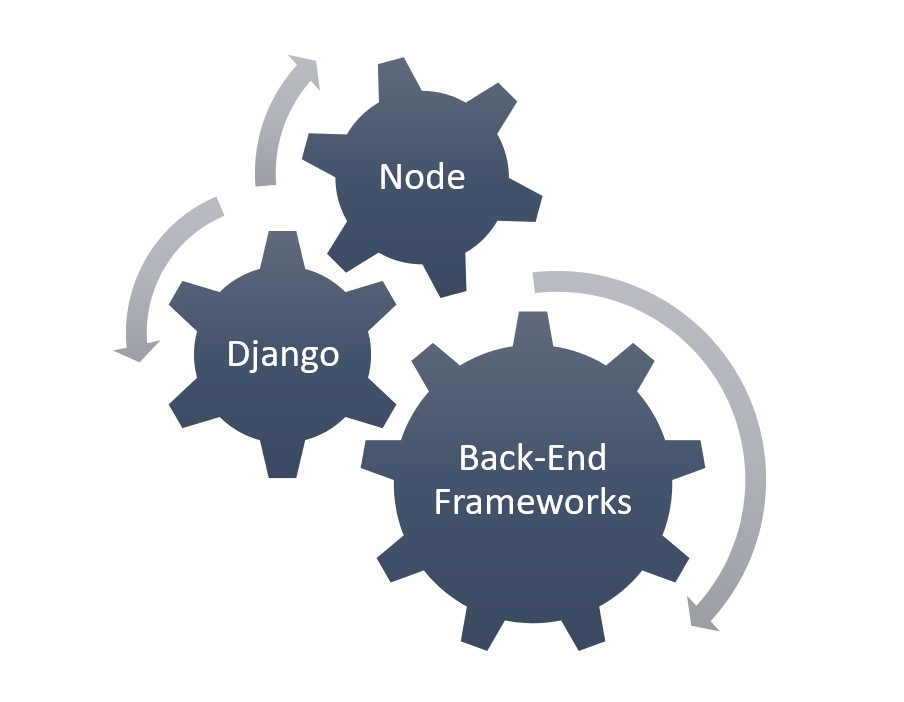
Back-end Frameworks
Back-end frameworks come in direct contact with full-stack web developers. As a result, they are popular in communities of software developers and have better online support. Below are some of the popular back-end frameworks in the market.
Django
It is an open-source back-end framework written using Python. It is a secure technology stack that allows rapid development of web applications. It provides a structure that enables web developers to create neat and logical designs. The framework follows an MVC pattern and runs independently on multiple platforms, including Windows, Mac, Linux, and PC.
Node
Node, also known as Node.js, is an open-source web development framework using JavaScript. It is renowned for its scalability and fast performance, using a server environment that enables the developer to create asynchronous event-driven tasks. Without the need for additional software and hardware support, it can process a large number of connections speedily.
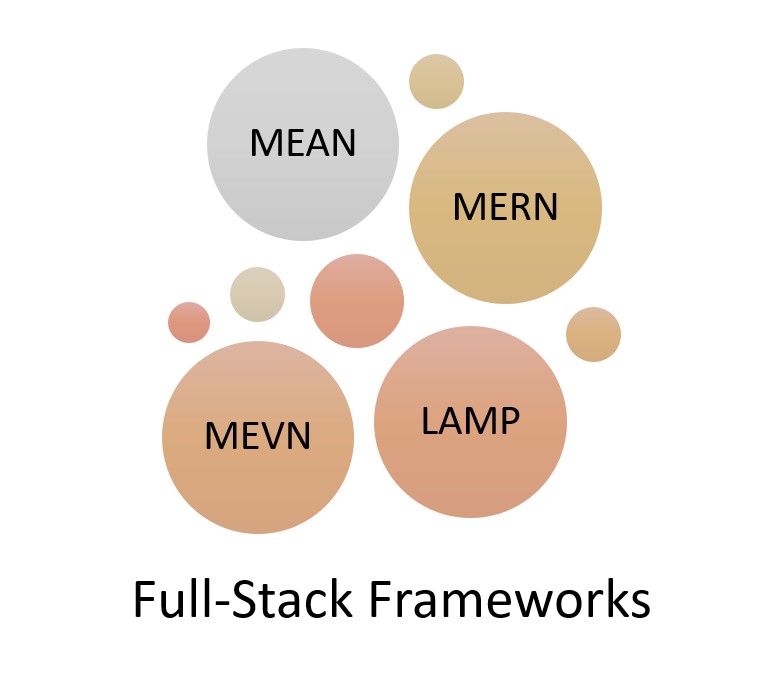
Full Stack Frameworks
Full stack frameworks provide the complete package that deals with the components of both the front and back end of the web development process. Some of the most popular frameworks in use nowadays are full-stack technologies. Let’s take a look at a few of the available options below.
MEAN
Used primarily to build dynamic websites and web applications, MEAN is an open-source framework based on JavaScript. It is considered to be the best and most popular web development stack option available in the market today. It is made up of the following four major technologies:
- Front-end framework: Angular and TypeScript
- Back-end framework: Express and Node
- Database: MongoDB
A major reason for its popularity is its ability to let developers create efficient web apps in the minimum possible time. Moreover, the use of a single programming language and its easy accessibility due to open source makes it a more lucrative option for web developers.
MERN
MERN is a web development stack framework that is very similar to MEAN. The primary difference lies in its front-end framework, which uses React instead of Angular. The slight change makes it a strong contender in the market, as integration with React enables developers to access a strong library source for both the front and back end of web development.
It is popular for its flexibility in creating high-end and single-page web applications with efficient interactivity. It has a highly performance-oriented approach and is rated as the second-most popular web stack framework in the market. Moreover, it has strong online community support along with extensive documentation and assistance.
MEVN
It is another variation of the MEAN framework. The basic difference is that the MEVN framework uses Vue as its front-end framework instead of the Angular in MEAN. It makes MEVN a lighter option that integrates the features of both Angular and React. It is also an open-source framework based on the programming language of JavaScript. It is developer friendly, responsive, and customizable.
LAMP
LAMP is a widely used open-source framework that is also considered to be an industry standard option in the market. Consisting of Linux, MySQL, Apache, and PHP, it runs efficiently on all operating systems. It is dynamic and user-friendly in its performance and supports the development of efficient web apps. It is the best choice in the market for the development of custom web applications.
Hence, using these frameworks provides great support to software developers in building their web apps. The technology stacks ensure the availability of a diverse range of tech stack components along with the needed support and documentation for quick and efficient results.
How to Choose a Web Development Stack?
A major hurdle in the web development process for enterprises is choosing the right web development stack. It becomes a tricky decision and usually, organizations look at their competitors before selecting the web stack. It is a difficult decision, owing to the diverse range of options available in the market nowadays. Companies face an overflow of information and options, each web technology stack claiming to be the best in the market. So how to choose?
The right way is to start with some self-reflection. The enterprise needs to look through the available options in the market. They should look at various factors of their web application requirement. The analysis clarifies several aspects and makes the web stack selection process simpler and straightforward.
Let’s take a look at some of the essential factors that must be considered before making a choice for a web application technology stack.
Complexity and Requirement of the Project
The primary point of focus is to understand the details of the project. The complexity and requirement of the web app should be taken into consideration. It is vital to take note as small applications require lesser tools, unlike websites for huge enterprises. Understanding the specific demands of the project enables you to create a clear idea of your requirements from a web development stack. It also determines the effort and finances available for the project.
To simplify the understanding process, the complexity of the project can be categorized into the following three categories.
Simple
Simple web applications can be built using off-the-shelf solutions with only basic tools of development. The web stack does not require access to extensive libraries or extra modules. Small businesses tend to opt for such web apps.
Medium
Medium apps are slightly more complex than simple ones. They have a greater number of features. They use structures in the development process and need additional frameworks as well. Online stores are a common example of this category of complexity.
Complex
This is the most complicated category of web apps. It requires multiple languages, web servers, libraries, and databases to build complex web apps. Using several web development techniques, these web applications have multiple functions and a scope of services.
Some other requirements include the type of website to be made, the development cost available for investment, the number of developers to be hired, and the time you have for development. Based on these factors, you can have a clear idea of the demands of your project.
Time to Market
In the rapidly advancing technological world, time is a crucial factor in developing new ideas and outcomes. Similarly, the web development process should also be scrutinized in terms of the development cycles. Quicker solutions offer advantages to enterprises in an already competitive market that requires popular technologies with ready-made features for instant use. Lesser time to market leads to a rapid development phase, resulting in reduced costs.
However, the timeline is determined by several factors. It depends on the number of new and unusual functionalities of a web application since they will not be readily available in the market. Development of these functionalities requires more time. Moreover, the option of third-party integration and accessibility of the needed documentation and support directly affects the time for development.
Scalability
At the start of a web development process, the major focus lies on the immediate requirements and targets of a web application. While the immediate concerns are of high importance, they should not let an enterprise lose sight of the long-term goal. It is of equal significance to evaluate the scalability of the structures and elements of your web development stack.
Depending on the constantly evolving online market, businesses can grow in a very short time. Scaling up can require an increased number of users, more traffic, and larger data storage. Businesses can use several frameworks and programming languages to ensure the scalability of their web applications.
Security
With the increased use of online resources, concerns for privacy have also risen. Enterprises collect important information from their customers, which makes it their responsibility to ensure the security of that data. It requires businesses to opt for the latest technological tools for their web application development that can provide a secure app for their customers. The use of API in all web interactions and implementing token-based APIs are some ways to enhance the security of a web app. Moreover, companies should also consider creating backups for all information.
The above-mentioned factors relate to some of the most important features and aspects of a web technology stack. Organizations must review their requirements based on these factors to ensure clarity in their decisions when choosing a web development stack.
Conclusion
Digital spaces have become crucial to enterprises over time. Everyone aims to maintain a strong position on the internet to secure their standing in the market. It has led to an increased reliance on websites as they offer a platform for businesses to interact with their customers. There are many tools and frameworks available in the market that ensure a rapid development process for web applications.
The web application technology stack provides a set of organized tools to assist software developers in the web development process. From full-stack web development to single-page applications, the tech stack offers a platform for a wide range of functions. So, as you begin your web design process, spend some time understanding a web development stack to align your selection with your requirements.
Jan 18, 2023
